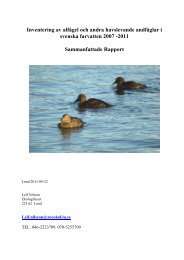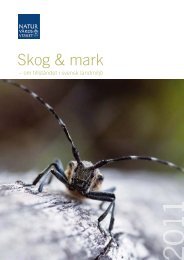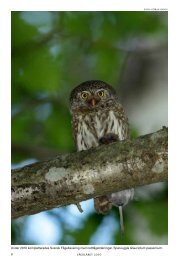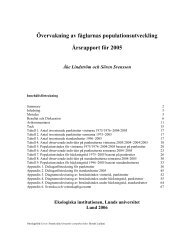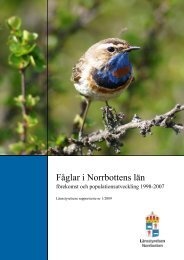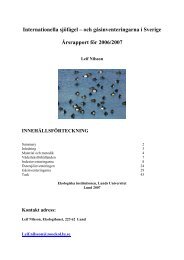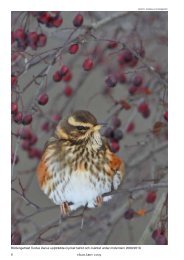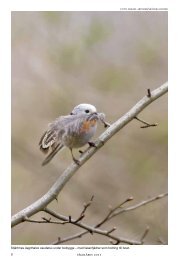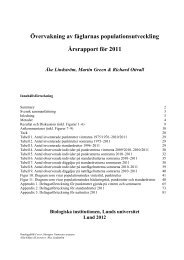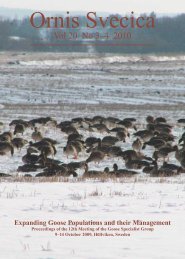Distribution and numbers of wintering sea ducks ... - Lunds universitet
Distribution and numbers of wintering sea ducks ... - Lunds universitet
Distribution and numbers of wintering sea ducks ... - Lunds universitet
You also want an ePaper? Increase the reach of your titles
YUMPU automatically turns print PDFs into web optimized ePapers that Google loves.
figure 3. The distribution <strong>of</strong> long-tailed Duck Clangula<br />
hyemalis in Swedish waters in the mild winter 2009 <strong>and</strong> the<br />
cold ice-winter 2011. The red line = border <strong>of</strong> ice.<br />
Utbredningen för alfågel Clangula hyemalis i svenska farvatten<br />
den milda vintern 2009 och den kalla isvintern 2011.<br />
Röd linje = isgränsen.<br />
not surveyed in 2009 but important <strong>numbers</strong> were<br />
found here in other years. On the mainl<strong>and</strong> coast<br />
only small <strong>numbers</strong> were counted on the south<br />
coast <strong>of</strong> Scania, <strong>and</strong> larger flocks from Hanöbukten<br />
<strong>and</strong> Kalmarsund north to Stockholm in the outer<br />
zone <strong>of</strong> the archipelagos (figure 3).<br />
In the two winters <strong>of</strong> 2010 <strong>and</strong> 2011, with hard<br />
ice conditions, the distribution <strong>of</strong> the long-tailed<br />
Duck in Sweden was markedly different. large<br />
<strong>numbers</strong> were concentrated to the <strong>of</strong>fshore banks,<br />
with an estimated total there <strong>of</strong> 630 000 in 2010 <strong>and</strong><br />
365 000 in 2011. In 2010 426 000 <strong>of</strong> these longtailed<br />
Ducks were found on Hoburgbank (Table 1,<br />
figure 4). The high counts on the <strong>of</strong>fshore banks in<br />
2010 <strong>and</strong> 2011 can most probably be related to the<br />
ice situation, especially on the eastern Baltic coast,<br />
where the important winter areas for the species<br />
1600000<br />
1400000<br />
1200000<br />
1000000<br />
800000<br />
600000<br />
400000<br />
200000<br />
0<br />
Other areas<br />
Hoburgs Bank<br />
Midsjö Banks<br />
1993 2009 2010 2011<br />
figure 4. The estimated population <strong>of</strong> long-tailed Duck<br />
Clangula hyemalis on the <strong>of</strong>fshore banks <strong>and</strong> in other Swedish<br />
areas during the surveys in 1992/93, 2009, 2010 <strong>and</strong><br />
2011.<br />
Det beräknade beståndet av alfågel Clangula hyemalis på<br />
de viktiga utsjöbankarna och <strong>and</strong>ra svenska områden vid<br />
inventeringarna 1992/93, 2009, 2010 och 2011.<br />
such as Irbe strait <strong>and</strong> the Riga bay were totally<br />
ice-covered in 2010 <strong>and</strong> 2011.<br />
The occurrence <strong>of</strong> long-tailed Ducks on the<br />
three major <strong>of</strong>fshore banks will be further discussed<br />
in another context, so I will not go into any<br />
details here. On Hoburgbank marked differences<br />
were found between the three years, related to the<br />
ice situation in the Baltic. On the Midsjö banks on<br />
the other h<strong>and</strong> the totals found in 2009 <strong>and</strong> 2010<br />
were largely similar, but <strong>numbers</strong> were appreciably<br />
lower in 2011. The northern Midsjö bank however<br />
had similar totals for all three years (Table 2).<br />
Compared to the first total survey <strong>of</strong> the Baltic<br />
<strong>sea</strong> in 1992/1993 there were marked differences in<br />
the total number <strong>of</strong> long tailed Ducks estimated<br />
for the Swedish part <strong>of</strong> the Baltic in the two censuses,<br />
1.41 million in the former compared to 0.44<br />
million in 2009. The two estimates are however<br />
based on different methods with different kinds <strong>of</strong><br />
bias, as discussed above.<br />
The changes between the two major surveys are<br />
not the same for all areas. for the main areas around<br />
Gotl<strong>and</strong>, Hoburgbank <strong>and</strong> the Midsjö banks, very<br />
marked differences were found between 1992/1993<br />
<strong>and</strong> 2009. Estimates for Hoburgbank were 90 000<br />
in 2009 compared to 925 000 in 1992/1993. for the<br />
east coast <strong>of</strong> Gotl<strong>and</strong> the estimates for the two surveys<br />
were 11 000 compared to 270 000. Numbers<br />
on the Midsjö banks were markedly higher in 2009<br />
than in 1992/1993 but this does not compensate<br />
for the decrease on Hoburgbank. Counts in 2009<br />
<strong>and</strong> 2010 were similar but <strong>numbers</strong> were markedly<br />
lower on the southern Midsjö bank in 2011 than in<br />
the two previous years (Table 2) but there was no<br />
43



